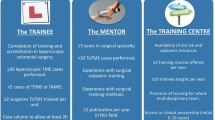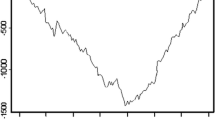Abstract
Background
With increasing interest in natural orifice surgery, there has been a dramatic evolution of transanal and endoluminal surgical techniques. These techniques began with transanal endoluminal surgical removal of rectal masses and have progressed to transanal radical proctectomy for rectal cancer. The first transanal total mesorectal excision (taTME) was performed in 2009 by Sylla, Rattner, Delgado, and Lacy. The improved visibility and working space associated with the taTME technique is intriguing. This video manuscript outlines the training pathway followed by pioneers in the taTME technique, the process of implementation into clinical practice, and initial case report.
Methods
A double board-certified colorectal surgeon with expertise in rectal cancer, minimally invasive total mesorectal excision, transanal endoscopic surgery (TES), and intersphincteric dissection, underwent taTME training in male cadaver models. Institutional review board (IRB) approval for a phase I clinical trial was achieved. The entire operative team including surgeons, nurses, and operative staff underwent taTME cadaver training the day prior to the first clinical case. The case was proctored by an expert in taTME.
Results
A 66-year-old male with uT3N1M0 rectal cancer located in the posterior distal rectum, underwent taTME with laparoscopic abdominal assistance, hand sewn coloanal anastomosis, and diverting loop ileostomy. The majority of the TME was performed transanally with laparoscopic assistance for exposure, splenic flexure mobilization, and high ligation of the vascular pedicles. Operative time was 359 min. There were no intraoperative complications. Pathology revealed a ypT2N1 moderately differentiated invasive adenocarcinoma, grade I TME, 1 cm circumferential radial margin, and 2/13 positive lymph nodes.
Conclusion
Implementation of taTME into practice can be achieved by surgeons with expertise in minimally invasive TME, TES, pre-clinical taTME training in cadavers, case observation, proctoring, and ongoing mentorship. IRB peer review process and participation in a clinical registry are additional measures that should be employed.

Similar content being viewed by others
References
Heald RJ (1988) The ‘Holy Plane’ of rectal surgery. J R Soc Med 88:503–508
Rea JD, Cone MM, Diggs BS, Deveney KE, Lu KC, Herzig DO (2011) Utilization of laparoscopic colectomy in the United States before and after the clinical outcomes of surgical therapy study group trial. Ann Surg 254:281–288
Marks GJ, Marks JH, Mohiuddin M, Brady L (1998) Radical sphincter-preserving surgery with coloanal anastomosis following high-dose external irradiation for the very low lying rectal cancer. Recent Results Cancer Res 146:161–174
Marks J, Mizrahi B, Dalane S, Nweze I, Marks G (2010) Laparoscopic transanal abdominal transanal resection with sphincter preservation for rectal cancer in the distal 3 cm of the rectum after neoadjuvant therapy. Surg Endosc 24:2700–2707
Buess G, Theiss R, Hutterer F, Pichlmaier H, Pelz P, Holfeld T et al (1983) Die transanale endoscopische Rektumoperation. Erprobung einer neuen Methode im Tierversuch. Leber Magen Darm 13:73
Buess G (1993) Review: transanal endoscopic microsurgery (TEM). J R Coll Surg Edinb 38:239–245
Middleton PF, Sutherland LM, Maddern GJ (2005) Transanal endoscopic microsurgery: a systematic review. Dis Colon Rectum 48:270–284
Moore JS, Cataldo PA, Osler T, Hyman NH (2008) Transanal endoscopic microsurgery is more effective than traditional transanal excision for resection of rectal masses. Dis Colon Rectum 51:1026–1030
Barendse RM, van den Broek FJ, Dekker E, Bemelman WA, de Graaf EJ, Fockens P, Reitsma JB (2011) Systematic review of endoscopic mucosal resection versus transanal endoscopic microsurgery for large rectal adenomas. Endoscopy 43(11):941–949
Allaix ME, Arezzo A, Caldart M, Festa F, Morino M (2009) Transanal endoscopic microsurgery for rectal neoplasms: experience of 300 consecutive cases. Dis Colon Rectum 52:1831–1836
Guerrieri M, Baldarelli M, de Sanctis A, Campagnacci R, Rimini M, Lezoche E (2010) Treatment of rectal adenomas by transanal endoscopic microsurgery: 15 years’ experience. Surg Endosc 24:445–449
Lacy AM, Adelsdorfer C (2011) Totally transrectal endoscopic total mesorectal excision (TME). Colorectal Dis 13(Suppl. 7):43–46
Gaujoux S, Bretagnol F, Au J, Ferron M, Panis Y (2011) Single port access proctectomy with total mesorectal excision and intersphincteric resection with a primary transanal approach. Colorectal Dis 13(9):e305–e307
Zhang H, Zhang YS, Jin XW, Li MZ, Fan JS, Yang ZH (2013) Transanal single-port laparoscopic total mesorectal excision in the treatment of rectal cancer. Tech Coloproctol 17(1):117–123
Sylla P (2010) Current experience and future directions of completely NOTES colorectal resection. World J Gastrointest Surg 2(6):193–198
Whiteford MH, Denk PM, Swanstrom LL (2007) Feasibility of radical sigmoid colectomy performed as natural orifice translumenal endoscopic surgery (NOTES) using transanal endoscopic microsurgery. Surg Endosc 21(10):1870–1874
Denk PM, Swanstrom LL, Whiteford MH (2008) Transanal endoscopic microsurgical platform for natural orifice surgery. Gastrointest Endosc 68(5):954–959
Fajardo AD, Hunt SR, Fleshman JW, Mutch MG (2010) Transanal single-port low anterior resection in a cadaver model. Surg Endosc 24:1765
Trunzo JA, Delaney CP (2010) Natural orifice proctectomy using a transanal endoscopic microsurgical technique in a porcine model. Surg Innov 17(1):48–52
Sylla P, Sohn DK, CizqinerS KonukY, Turner BG, Gee DW, Willingham FF, Hsu M, Mino-Kenudson M, Brugge WR, Rattner DW (2010) Survival study of natural orifice transluminal endoscopic surgery for rectosigmoid resection using transanal endoscopic microsurgery with or without transgastric endoscopic assistance in a swine model. Surg Endosc 24(8):2022–2030
Sylla P, Willingham FF, Sohn DK, Gee D, Brugge WR, Rattner DW (2008) NOTES rectosigmoid resection using transanal endoscopic microsurgery (TEM) with transgastric endoscopic assistance: a pilot study in swine. J Gastrointest Surg 12(10):1717–1723
Han Y, He YG, Zhang HB, Lv KZ, Zhang YJ, Lin MB, Yin L (2013) Total laparoscopic sigmoid and rectal surgery in combination with transanal endoscopic microsurgery: a preliminary evaluation in China. Surg Endosc 27(2):518–524
Bhattacharjee HK, Kirschniak A, Storz P, Wilhelm P, Kunert W (2011) Transanal endoscopic microsurgery-based transanal access for colorectal surgery: experience on human cadavers. J Laparoendosc Adv Surg Tech A 21:835–840
Sohn DK, Jeong SY, Park JW, Kim JS, Hwang JH, Kim DW, Kang SB, Oh JH (2011) Comparative study of NOTES rectosigmoidectomy in a swine model: E-NOTES vs P-NOTES. Endoscopy 43(6):526–532
Sylla P, Rattner DW, Delgado S, Lacy AM (2010) NOTES transanal rectal cancer resection using transanal endoscopic microsurgery and laparoscopic assistance. Surg Endosc 24(5):1205–1210
Telem DA, Han KS, Kim MC, Ajari I, Sohn DK, Woods K, Kapur V, Sbeih MA, Perretta S, Rattner DW, Sylla P (2013) Transanal rectosigmoid resection via natural orifice translumenal endoscopic surgery (NOTES) with total mesorectal excision in a large human cadaver series. Surg Endosc 27(1):74–80
Atallah S, Albert M, Larach S (2010) Transanal minimally invasive surgery: a giant leap forward. Surg Endosc 24(9):220–225
Cid RC, Perez JC, Elosua TG (2011) Transanal resection using a single port trocar: a new approach to NOTES. Cir Esp 89:20–23
Dumont F, Goéré D, Honoré C, Elias D (2012) Transanal endoscopic total mesorectal excision combined with single-port laparoscopy. Dis Colon Rectum 55(9):996–1001
Fajardo AD, Hunt SR, Fleshman JW, Mutch MG (2010) Video. Transanal single-port low anterior resection in a cadaver model. Surg Endosc 24:1765
McLemore EC, Coker A, Jacobsen G, Talamini MA, Horgan S (2013) eTAMIS: endoscopic visualization for transanal minimally invasive surgery. Surg Endosc 27(5):1842–1845
McLemore EC, Coker A, Leland H, Yu PT, Devaraj B, Jacobsen G, Talamini MA, Horgan S, Ramamoorthy S (2013) New disposable transanal endoscopic surgery platform: longer channel, longer reach. Glob J Gastroenterol Hepatol 1:36–40
McLemore EC, Weston LA, Coker AM, Jacobsen GR, Talamini MA, Horgan S, Ramamoorthy SL (2014) Transanal minimally invasive surgery for benign and malignant rectal neoplasia. Am J Surg 208(3):372–381
McLemore EC, Leland H, Devaraj B, Pola S, Docherty MJ, Patel DR, Levesque BG, Sandborn WJ, Talamini MA, Ramamoorthy SL (2013) Transanal endoscopic surgical proctectomy for proctitis case series report: diversion, radiation, ulcerative colitis, and Crohn’s disease. Glob J Gastroenterol Hepatol 1:41–47
McLemore EC, Coker A, Devaraj B, Chakedis J, Maawy A, Inui T, Talamini MA, Horgan S, Peterson MR, Sylla P, Ramamoorthy S (2013) TAMIS assisted laparoscopic low anterior resection with total mesorectal excision in a cadaveric series. Surg Endosc 27:3478–3484
Lacy AM, Tasende MM, Delgado S, Fernandez-Hevia M, Jimenez M, DeLacy B, Castells A, Bravo R, Wexner SD, Heald RJ (2015) Transanal total mesorectal excision for rectal cancer: outcomes after 140 patients. J Am Coll Surg 221(2):415–423
Hohenberger W, Merkel S, Hermanek P (2013) Volume and outcome in rectal cancer surgery: the importance of quality management. Int J Colorectal Dis 28(2):197–206
Wexner SD, Rotholtz NA (2000) Surgeon influenced variables in resectional rectal cancer surgery. Dis Colon Rectum 43(11):1606–1627
Hompes R, Arnold S, Warusavitarne J (2014) Towards the safe introduction of transanal total mesorectal excision: the role of a clinical registry. Colorectal Dis 16(7):498–501
Acknowledgments
The authors wish to acknowledge Steven Wexner, MD, Dana Sands, MD, and Eric Weiss, MD, Cleveland Clinic Florida, for their dedication to training and mentoring colorectal surgery residents as well as their ongoing interest, support, and earnest enthusiasm toward advancing the field of minimally invasive colon and rectal surgery. The authors acknowledge the multitude of simulation and training thought leaders within the field of industry who have supported the taTME cadaver surgical training courses including but not limited to: Richard Wolf Medical Instruments Corporation, Karl Storz GmbH & Co, Applied Medical, Covidien/Medtronic, Nodadaq Inc., Stryker Endoscopy, and Novatract. The authors respectfully acknowledge Antonio Lacy for his excellent surgical technique, scientific approach to the evaluation and implementation of the taTME technique into clinical practice, and ongoing training, proctoring, and mentorship within the rectal cancer surgical community.
Author information
Authors and Affiliations
Corresponding author
Ethics declarations
Disclosures
Dr. McLemore reports grants from Applied Medical, grants from Applied Medical, grants from Covidien, grants from Stryker Endoscopy, grants from Novatract, during the conduct of the study; personal fees from Applied Medical, personal fees from Novadaq, personal fees from Cubist, personal fees from Genomic Health, personal fees from Ethicon Endosurgery, personal fees from Covidien, outside the submitted work. Dr. Harnsberger has nothing to disclose. Dr. Broderick reports grants from Applied Medical, grants from Applied Medical, grants from Covidien, grants from Stryker Endoscopy, grants from Novatract, during the conduct of the study. Dr. Leland reports grants from Applied Medical, grants from Applied Medical, grants from Covidien, grants from Stryker Endoscopy, grants from Novatract, during the conduct of the study. Dr. Sylla has nothing to disclose. Dr. Coker reports grants from Applied Medical, grants from Applied Medical, grants from Covidien, grants from Stryker Endoscopy, grants from Novatract, during the conduct of the study. Dr. Fuchs reports grants from Applied Medical, grants from Applied Medical, grants from Covidien, grants from Stryker Endoscopy, grants from Novatract, during the conduct of the study. Dr. Jacobsen reports grants from Applied Medical, grants from Applied Medical, grants from Covidien, grants from Stryker Endoscopy, grants from Novatract, during the conduct of the study; personal fees from ValenTx, Inc., personal fees from Gore, personal fees from Davol, personal fees from Ethicon Endosurgery outside the submitted work. Dr. Sandler reports grants from Applied Medical, grants from Applied Medical, grants from Covidien, grants from Stryker Endoscopy, grants from Novatract, during the conduct of the study; personal fees from ValenTx, Inc., personal fees from Gore, personal fees from Davol outside the submitted work. Dr. Attaluri has nothing to disclose. Mrs. Tsay, NP, has nothing to disclose. Dr. Wexner reports other from Covidien, personal fees from Karl Storz Endoscopy America, other from Karl Storz Endoscopy America, during the conduct of the study. Dr. Talamini reports grants from Applied Medical, grants from Covidien, grants from Stryker Endoscopy, grants from Novatract, during the conduct of the study. Dr. Horgan reports grants from Applied Medical, grants from Applied Medical, grants from Covidien, grants from Stryker Endoscopy, grants from Novatract, during the conduct of the study.
Additional information
This video abstract received the 2014 SAGES Foundation Gerald Marks Rectal Cancer Award 4/2/14, SAGES Annual Meeting and Scientific Session, Salt Lake City, UT, USA.
Electronic supplementary material
Below is the link to the electronic supplementary material.
Cadaveric taTME Dissection. Transanal total mesorectal excision in a male cadaver model (MP4 89577 kb)
Clinical taTME Dissection. Transanal total mesorectal excision, clinical case report and pelvic dissection (MP4 171823 kb)
Rights and permissions
About this article
Cite this article
McLemore, E.C., Harnsberger, C.R., Broderick, R.C. et al. Transanal total mesorectal excision (taTME) for rectal cancer: a training pathway. Surg Endosc 30, 4130–4135 (2016). https://doi.org/10.1007/s00464-015-4680-1
Received:
Accepted:
Published:
Issue Date:
DOI: https://doi.org/10.1007/s00464-015-4680-1




